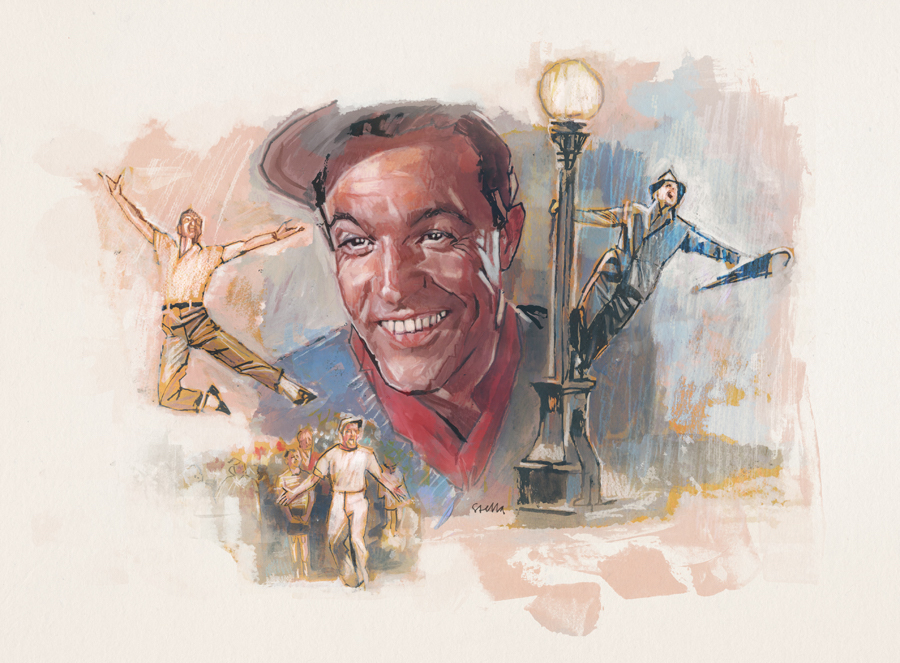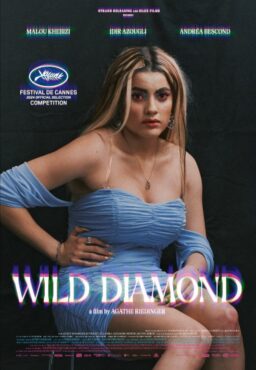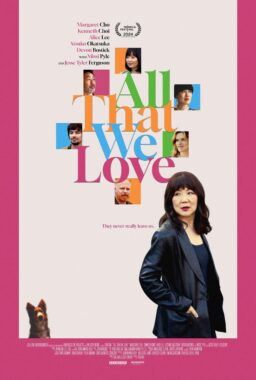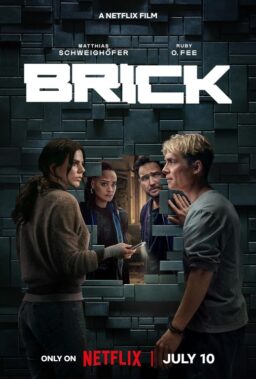We are pleased to offer an excerpt from the February 2021 edition of the online magazine, Bright Wall/Dark Room. Their February issue revolves around Music & Movies, and in addition to Ethan Warren’s piece below about Gene Kelly, it also features new essays on “Marie Antoinette,” “Chariots of Fire,” “A Mighty Wind,” “House (1977),” “A Prairie Home Companion,” “Buena Vista Social Club,” “Meghe Dhaka Tara,” “Comrades: A Love Story,” “Evening Primrose,” “The Sound of Noise,” “Who’s That Singing Over There?,” and a profile of Oscar Levant.
You can read our previous excerpts from the magazine by clicking here. To subscribe to Bright Wall/Dark Room, or look at their most recent essays, click here. The above art is by Tony Stella.
The opening moments of 1942’s For Me and My Gal see a train arriving in a small-town junction. As a stream of touring vaudevillians step off to prepare for another night of puttin’ on a show, exchanging jokes and good-natured insults, one local points off-screen, remarking, “Say, he looks like an actor!” With a quick cut that suggests little of the significance this moment will hold in film history, we find a 30-year-old ingenue named Gene Kelly alighting from the train behind his colleagues. “You called it, friend,” he agrees, his entire face overtaken by the force of his grin.
“Just look at that,” I sighed to my eldest daughter as we watched Busby Berkeley’s rousing wartime romance one afternoon early in 2021, a few months after she turned 4. “Gene Kelly walking onto the screen for the first time. What a moment.” And across the remainder of that lazy afternoon, her newborn sister dozing on my chest, my daughter lapsed into a recurring habit: every 10 minutes or so, she would turn to me and say it once more. “Look at that! Gene Kelly walkin’ on the screen!”
It was hard not to laugh—though it was essential that I not, given how recently self-consciousness had entered her life, making any expression of unexpected delight a potential landmine of hurt feelings. Though she was attempting to match my energy as we took in our seventh Kelly movie in as many months, she had clearly only halfway grasped my point. Yet at the same time, it was hard to disagree with her repeated proclamation. Gene Kelly walking onto the screen—it really doesn’t get a whole lot better than that.
Self-consciousness was not the only unfamiliar sensation to enter my eldest daughter’s life this past year. Those 12 months were a time of explosive new awareness as she grappled with life’s potential for confusion and anxiety, be it centered on her home, the world beyond, or her own heart. As she outgrew her mind’s protective layers, exposing new frontiers of psychic raw nerves, even the movies she had previously turned to for pleasure and distraction revealed new sinkholes of terror. And as that year saw the protective layer on my own mind cracking in ways I never expected, the two of us found ourselves looking increasingly towards the same safe haven: Gene Kelly walking—or, more appropriately, dancing—across the screen.
He had rhythm. He had style. Who could ask for anything more?
—
In 2018, a few days before my daughter’s second birthday, my wife went into labor, heralding the arrival of a little brother. It was a long, anxious, rainy day and this small bundle of nerves—only barely able to grasp what was going on but very much aware that something was going on—required captivating distraction. The time would have seemed ideal to reach for the remote and sink the morning into a movie, but we had only recently introduced screens into her life and she had yet to be fully gripped by the concept. We had begun with easy choices from the Disney Animation and Pixar canons, and while each one had intrigued her for a time, her ability to sit still had not yet evolved to the point of enjoying an entire feature. If the denizens of Wonderland and Andy’s room had failed to engage, it was hard to imagine what might. An outside-the-box pick was clearly in order.
With a 103-minute runtime that well exceeded any movie we’d tried before, 1952’s Singin’ in the Rain might have seemed a bad bet. But, I reasoned, perhaps the rhythms of classic Hollywood might sync with her mental wavelength in a way those more frenetic animated efforts had failed to do. Singin’ in the Rain isn’t precisely a relaxed movie, opening as it does with a kinetic years-spanning montage that relies on a keen appreciation of ironic counterpoint between dialogue and image, but without a moment’s hesitation, my daughter was transfixed. Curled up on the couch at the sort of impossible angle comfortable only to pre-toddlers—one knee elevated and the other splayed; right arm wrapped fully around left shoulder; weight held entirely on one hip—her eyebrows bunched with focus. She leaned forward with intrigue. She melted back into absolute relaxation. The Tinseltown angst of silent pictures giving way to talkies could hardly have been less comprehensible to her, but in a Gene Kelly movie, dialogue is so often beside the point. The meaning of any given scene is conveyed just as well through heightened body language—Debbie Reynolds bursting ecstatic from a cake only for her face to fall into shocked dismay at the sight of Kelly’s bemusement; Kelly and Reynolds leaning, longing, against opposite sides of a ladder on an empty soundstage backed by a rear-projected sunset. In his 1992 BFI Classics volume on Singin’ in the Rain, Peter Wollen argues that “Kelly succeeded in recapturing for the cinema an aesthetic which had been almost lost since the silent days:” the expressive power of the human form as superior to the relatively paltry efforts of language.
Only once during that first viewing did my daughter leave the couch. During the tongue-twisting tap-dance duet between Kelly and Donald O’Connor—Moses supposes his toeses are roses, but Moses supposes erroneously!—she abruptly hopped down, and though I feared we’d exceeded the limits of her attention, she didn’t leave the room. Instead, she brought herself as close as possible to the screen, craning her gaze upwards to study the flying feet, flailing knees, and whirling arms with unbroken focus. When I look back on that day, I see two major milestones: it was the day my son was born, and—less momentous but easily more surprising—it was the day Gene Kelly convinced my daughter to watch an entire movie.
—
Decades after the image of an umbrella-toting man swinging from a lamppost passed the point of ubiquity, it can be hard to verbalize exactly what makes Gene Kelly an enduring screen presence. From an intellectual vantage, it’s easy to admire his accomplishments—his insistence that dance be a form of character expression in a time when it was more often a show-stopping display; his drive to integrate location shooting in a time when the Hollywood musical was resolutely stagebound; his ease dancing in street clothes in a time when viewers expected tap shoes to come with top hat and tails—but how to account for a child’s intuitive fascination?
Maybe it’s precisely the unintuitive nature of Kelly’s appeal that makes him so eternally magnetic. In his youth, Kelly modeled his presence in equal parts on Douglas Fairbanks and Buster Keaton, and as he began his career in earnest, that self-image shifted to a combination of Fred Astaire and James Cagney. This tension between swagger and self-deprecation, machismo and delicacy, generates a static charge that’s hard to miss even if you can’t fully describe it. Kelly was an innovator not just in what dance could be but in what he could be. “He attributes his longevity as a dancer to his excitement at finding a new field to conquer,” Peter Wollen writes of Kelly’s relatively late-breaking directorial career, “which prolonged his physical mobility and energy beyond what he had a right to expect.” Watching Kelly and Donald O’Connor pummel the floor with their tap shoes in the “Moses Supposes” sequence, the feat is all the more breathtaking when considering that at 40, Kelly is keeping up with a co-star more than a decade his junior.
Much as his acrobatic skill may have been his stock in trade, I’d wager Gene Kelly’s status as a legend is attributable in equal measure to his smile. The Kelly smile is a full-body gesture, creating the impression that a grin is his natural state while a scowl is the performative gesture. Early in his his 1958 TV special Dancing: A Man’s Game—the most concentrated effort in his lifelong mission to demonstrate the alignment of strength and grace shared by both sports and dance—Kelly flubs one of his prepared lines, and his face explodes in a bemused grin bearing not a trace of dismay or embarrassment. It’s easy to wish he’d trip over every subsequent line just to get another glimpse of that unselfconscious zeal, that smile on his face for the whole human race.
—
It was more than a year after our first viewing of Singin’ in the Rain that my daughter and I returned to the world of Gene Kelly. Now on the far side of 3, her interest in movies had grown and deepened, but she had recently turned a corner towards skittishness that made selecting an agreeable option a tense process. What had begun as a discomfort with clear on-screen peril had expanded into an insurmountable anxiety surrounding everything from moody lighting to minor-key scoring. She was again unable to sit for an entire movie, but now when she leapt off the couch and fled the room, it was due not to distraction but terror. And so, on another long, tough day—this one fraught not with anything as significant as a sibling’s birth but with the slow-motion anxiety we experienced every time my wife left for a 12-hour shift at the hospital in the midst of a still-young global pandemic—requiring a surefire movie pick, I remembered that magic key I hadn’t reached for in so long: Gene Kelly.
Now with two discerning viewers by my side—a skittish daughter and a son in the grips of the distractibility that had plagued his sister around the time he was born—I selected 1951’s An American in Paris, and lightning struck twice. The simple plot was conveyed so effectively through Kelly’s ecstatic frame and expressive face that my son’s still-tenuous grasp of language hardly mattered. The three of us lost ourselves in this candy-colored, high-spirited tale of friends, lovers, and dreamers. When Kelly danced, my discerning viewers danced along with him, their feet flailing with little of his grace but all of his bliss, and when a swelling of score accompanied his ecstatic rush towards the camera, their tightly-wound dad gasped and let loose an involuntary and cathartic, “I love movies!”
As the tension that brought us back to Gene Kelly continued to mount throughout the ensuing months—as my daughter was pulled out of preschool temporarily and then indefinitely; as she lost the ability to be held by extended family; as she learned the significance of new words from “virus” to “protest” to “election;” as her parents shared the news that there would be another baby soon only for their spirits to be weighed down as her mom disappeared for frequent doctor’s visits; as death became a looming presence in her life with the loss first of a beloved neighbor and then her great-grandfather—her tolerance for movies grew vanishingly slight. Still, her desire to lose herself in a cinematic story was no weaker for the stress, and when it came time to pick a movie, she soon developed a new term: she wanted to see one with “our guy.”
We followed “our guy” on an amorous shore leave in Anchors Aweigh from 1945, to the cobbled streets of the Carribean in The Pirate from 1948, on the road with the Chicago Wolves in Take Me Out to the Ball Game from 1949, on another amorous shore leave in 1949’s On the Town, to idyllic farmlands for Summer Stock from 1950, and on a disenchanting reunion with wartime pals in 1955’s It’s Always Fair Weather. And each time, we went in assured of one thing: no character would be in any credible danger, and no mood would be unmanageably clouded with tension.
I don’t mean to suggest that Gene Kelly’s work with MGM’s legendary Freed Unit is anodyne or oblivious to the world’s ills. The climax of The Pirate centers on the threat of his character’s death by hanging, while the customary “dream ballet” in that case depicts a hyperbolically violent battle aboard a flaming ship’s deck. The characters in An American in Paris all shoulder the weight of their wartime experiences, be it the infantry service of Kelly’s protagonist or the lingering trauma of his Parisian love interest’s separation from her resistance fighter parents. For Me and My Gal features a bracing third-act shift to the war-torn western front, while his It’s Always Fair Weather character has been so crushed by postwar ennui that he’s abandoned his dreams of law and fallen prey to gambling and racketeering. If cueing up a Gene Kelly vehicle isn’t about the promise of utopian content, then, it must be about the promise of a utopian attitude.
Nowhere is this more acute than in the differences between An American in Paris and its 2014 stage adaptation. There, history is sketched vividly as screaming, teeming crowds struggle before swastikas drenched in red lighting, the production presumably operating on the logic that this story will carry greater resonance if the audience is fully aware of its brutal context. By that token, perhaps you could accuse the film of cheating, or even lying. But it seems more likely to me that the choice is emblematic of an essentially Gene Kelly approach to storytelling. “If you’re making musicals for a mass audience,” Kelly once said, “with few exceptions your goal is to bring joy.” And if anything unites these Gene Kelly classics, it’s a belief that no past experience could be horrific enough to prevent you from letting loose that whole-human-race encompassing smile and falling in love with life all over again.
—
From her earliest fascination with “Moses Supposes,” my daughter’s fondness for Gene Kelly was inextricable from her love of dance—by which I mean dance in the purest toddler sense of highly aerobic, questionably rhythmic flailing to any song with a sufficient tempo. Virtually as soon as she could form sentences, she was assuring us she was “workin’ on a new dance” only to fall into what could best be described as “a fit,” assuring us between gasps that these new steps were particularly tough to master. But as her discomfort with laughter manifested—be it the fear that her parents might delight in a malapropism or that her peers might mock differences in her appearance or skills—she began looking at Gene Kelly with a sense of defeatism. “He was so good,” she would sigh. “I’ll never be as good as him.”
But Gene Kelly, I hastened to tell her, would have hated that line of thought. Kelly began his career as a dance instructor, and spent the remainder of his life delighting in young dancers who, in the words of biographers Cynthia and Sara Brideson, “danced purely from emotion rather than constricting their styles to cerebral theories.”
There’s a clear childlike exuberance to Kelly’s performances, not only in his seemingly boundless energy but in his voracious curiosity. The most memorable number in Summer Stock is the one that Kelly dances not with Judy Garland but with a squeaky board and a discarded sheet of newspaper, a five-minute exploration of space, noise, and texture that grows from idle curiosity to sensory ecstasy as Kelly exalts in the sound of a perfectly-torn strip of newsprint before briefly play-acting as a matador, all for the apparent entertainment of nobody but himself. It’s a thrill shared by character and performer—Kelly reportedly experimented endlessly with various newspapers of various ages before determining that three-month-old copies of the Los Angeles Times offered the ideal sound beneath his tapping toe—and so transmitted inescapably to the viewer.
It’s often been noted that Kelly eschewed long-term dance partners along the lines of Astaire’s legendary association with Ginger Rogers, most often dancing either alone or alongside other men. Yet so many of Kelly’s most exuberant dances were those he performed either for children or alongside them. In Anchors Aweigh, he treats a mournful young girl to a routine of rhythmic clowning and jump-rope tricks before prancing her across the square and waltzing alone into the sunset with a trail of joy left in his wake. In Living in A Big Way from 1947, he gallivants across an elevated construction site to the cheers of the young crowd below, while in 1967’s Jack and the Beanstalk he dances alongside 9-year-old Bobby Riha as though the untrained boy were an equal on the order of Donald O’Connor.
In An American in Paris, Kelly reconfigures “I Got Rhythm” as a call-and-response number between himself and a crowd of Parisian schoolchildren, reveling in their unstudied performances—when a boy eagerly steps on one of his peer’s lines, Kelly throws him a reproachful cocked eyebrow and a hair-tossing headlock, and the embarrassed giddiness that cascades across the boy’s face after Kelly has moved on testifies to the infectious realness of the moment. In the dizzying demonstration that follows, Kelly transitions from flourishes of tap and Charleston to a series of moves he calls “choo-choo train,” “cowboy,” and “airplane,” all of them slight variations on his typical repertoire. It’s the child’s-eye view of the mission he would undertake a few years later in “Dancing: A Man’s Game,” when he collaborated with Mickey Mantle, Sugar Ray Robinson, and other pro athletes to translate their signature moves into steps. Anyone can dance, Kelly believed, and not just that, you probably do it every day whether you know it or not.
If Kelly’s scenes with young co-stars suggest the babysitter of any child’s dreams, it’s no surprise that he should have as much chemistry with synthetic co-stars. His dance with Jerry the mouse in Anchors Aweigh may be the technical marvel, but more poignant is his 1981 appearance on The Muppet Show, in which he serenades Miss Piggy and Gonzo, provides a soft-shoe lesson to Kermit, and finally joins the full felt cast in a round of “Singin’ in the Rain” before taking a solo walk across a recreation of the MGM backlot in a long, stately crane shot. Kelly’s episode has the distinction of being the last one filmed before production wrapped on the series, a choice that feels counterintuitively perfect. Henson, whose own approach to entertainment was deeply rooted in the sturdiness of classic dancehall routines, would know better than anyone the spiritual value of finishing his five-season project with a pioneering song-and-dance man taking one last stroll through the past on his way to whatever comes next.
—
“I was thinking about writing something about Gene Kelly, and how much you like him,” I told my daughter recently, and her visible distress at my suggestion made me fear I’d risked violating the sanctity of this oasis we’d carved out for ourselves. But no, I had simply misunderstood the strength of her feelings. “I don’t like him,” she stressed. “I love him with my whole heart!”
As death and loss became a specter in her life over the past year, she’s grown increasingly intrigued by her own place within a family tree. She asks for stories of life before her, not just ones featuring her parents and grandparents but their grandparents, attempting to contextualize her own experiences by positioning them within the flow of time. Her middle name was taken from a great-grandmother that neither she nor I ever knew, lending an additional acuteness to her yearning for an impossible relationship, but after I mentioned that her great-grandmother had been a passionate fan of Gene Kelly, she began reporting a recurring dream: she and all of her great-grandparents are gathered in our TV room, watching Gene Kelly movies. The dreams seem to be exceptionally vivid, and though I’m not prone to believing in visitations from the departed, it’s hard not to think of the 18th century Highlands farmer that Kelly’s lovesick tourist meets on that magical era-spanning bridge in 1954’s Brigadoon. “You woke me up!” the old man exclaims, and when he’s met by disbelief from Kelly’s character, he insists that such a miraculous event isn’t too surprising; with a deep enough love in your heart, anything is possible.
In a 1994 essay for The New Yorker, John Updike turns a skeptical eye on Kelly’s work. “He tends to be remembered as the Astaire-not,” Updike claims. Where Astaire “weightlessly [swirled] through a polished and heavenly space,” Kelly’s screen presence carries “something desperate…an attention-getting excessiveness” that bespeaks the two dancers’ respective positions at the dawn and the twilight of the golden age of Hollywood musicals.
It’s true that the two men reached middle age in dramatically different landscapes. When Astaire hit his mid-50s, he starred in The Band Wagon in 1953, a high point for the Freed Unit, while at the same age Kelly was being used for postmodern value in Jacques Demy’s nouvelle-vogue riff on Freed classics, The Young Girls of Rochefort in 1967. Where Astaire’s final song-and-dance role came in the last gasp of the Technicolor musical with 1968’s Finian’s Rainbow—a year before Kelly directed Hello, Dolly! in 1969, widely credited with helping put the nail not just in the big-budget musical but in the studio system as a whole for the next decade—Kelly’s swan song was the legendary folly Xanadu in 1980, another movie that uses him primarily for the human production value of inserting the genuine article into a self-aware simulacrum of the classics.
Yet the irrepressible effortfulness that chafed for Updike means even a project as deliriously unwatchable as Xanadu contains pockets of enchantment. The one legitimately poignant sequence finds Kelly, now pushing 70, dancing soft-shoe with the manifestation of his long-lost love, bridging the gap of time through force of passion. Astaire may have possessed Updike’s “feathery lightness,” but as impressive as I find his ballroom routines, I find nothing heartening about them. When I want to be reminded why I love movies, I’m looking not for cerebral theory but for pure emotion—for the guy who may be long past his prime but hasn’t forgotten how to let a grin overtake his face as he dances hard enough to hold back the tides of time.
Accepting the AFI Lifetime Achievement Award in 1985, Kelly admitted that making movies with MGM was “a lot of hard work…but we had fun. We had the best of times. And I think it was because we all thought we were trying to create some kind of magic and joy. That’s what you do up there. You dance love, and you dance joy.”
Kelly’s voice broke during his speech, and watching it today, it’s hard not to be choked with emotion alongside him. Life and the people who live it seem ever more capable of stressing our psychic protections. But as long as there are dances of whole-heart love still ricocheting across history, ones joyful enough to offer peace to a child born two decades after the dancer died, there might yet be hope for the whole human race. Personally, I can’t imagine asking for anything more.











